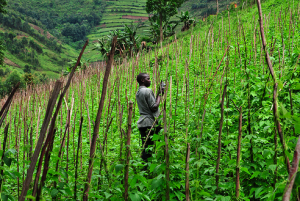- 2 reads

Whether a bowl of rice or a piece of bread, staple foods provide millions of poor people around the world with a source of basic sustenance day in and day out. Now, a new technology promises to make these foods-which provide calories but do not always contain enough of the micronutrients required for good health-more nutritious.
People who intake insufficient amounts of iron, zinc, and vitamin A can suffer from a hidden hunger," often with serious consequences. Without zinc, an eight-year-old girl may have the stature of a five-year-old. A young boy who doesn't receive enough vitamin A-an amount easily provided daily by a small orange sweet potato-could face permanent blindness. These precious nutrients, needed in only minute amounts, can make or break a young person's life and haunt them through adulthood.
The ideal solution - a more diverse diet - is beyond the reach of millions of poor people living in often-remote rural areas. This is where more nutritious staple foods can help. Through a process called biofortification, scientists are breeding new varieties of staple food crops that are richer in micronutrients. They scour seed banks to find seeds that contain the desired nutrients and then breed these into popular varieties using conventional methods.
The first crop out the door was sweet potato, a staple food in many parts of Africa, traditionally eaten in its white or yellow forms. Working with partners, the global agricultural research program HarvestPlus successfully released an orange sweet potato in Uganda and Mozambique that is far richer in vitamin A than yellow or white varieties. Children and women, the populations most susceptible to vitamin-A deficiency, are eating substantially more of this locally grown root vegetable.
"Me and my family are experiencing better health with fewer visits to the local clinic since we incorporated the orange sweet potato into our diet," a farmer in Uganda recently attested to visiting HarvestPlus staff. The organization and its partners will soon release two other nutritious staple foods in Africa: beans containing more iron and a vitamin A-rich maize.
Jean D'Amour Manirere, HarvestPlus Country Manager for beans, is currently testing the iron-rich bean varieties through field trials, with the goal of ultimately offering them to farmers and consumers in Rwanda, a country of lush rolling hills that claims beans as its staple crop. "Beans are the bread of Rwanda," Manirere says.
HarvestPlus is conducting a feeding trial to demonstrate that the new iron-rich beans reduce iron deficiency, a condition that leaves at least half of Rwanda's preschoolers physically and mentally impaired. With this seal of approval, local partners will be able to get the beans out to smallholder farming communities throughout the country. Farmers will be able to save and share seed to grow, year after year.
HarvestPlus expects that millions of Rwandans will be eating the beans within the decade. Once the beans have taken root in Rwanda, neighboring Democratic Republic of Congo and several other African countries where people regularly eat beans will also benefit.
In Zambia, a different crop that has become synonymous with African diets is about to become more nutritious: maize. The new maize varieties are a distinct orange color due to their vitamin-A content. HarvestPlus partners will begin releasing these varieties in provinces where rural households grow maize and where the incidence of vitamin-A deficiency among women and children is high.
"First, we want to confirm that these varieties perform well in the field," says Eliab Simpungwe, HarvestPlus Country Manager for maize. "We are already working with two seed companies to test this maize in the field."
How do people react to these new "orange" crops? HarvestPlus has found that when you explain the nutritional benefits, people are willing to include these foods in their diet. A HarvestPlus study in Zambia found that there is no stigma attached to orange maize, so the color should not be an issue. Coupled with its more nutritious profile and good field performance, the crop should easily carve out a niche in farmers' fields-and the Zambian diet. Once proven in Zambia, orange maize will be adapted to numerous other countries where maize is a popular food, in Africa and beyond.
Biofortification may ultimately prove to be most successful because it uses food crops that rural communities are already growing and eating to deliver better nutrition. It also has built-in sustainability. Once scientists have bred the high-nutrient into the crop, it stays there-nourishing many generations to come.
Yassir Islam is Senior Communications Specialist at HarvestPlus, a program of the Consultative Group on International Agricultural Research (CGIAR).
Visit Worldwatch's Nourishing the Planet blog to learn more about efforts to improve nutrition across sub-Saharan Africa through agricultural innovations.
A version of this article originally appeared on the Worldwatch Institute blog Nourishing the Planet. For permission to republish this article, please contact Juli Diamond at jdiamond@worldwatch.org.

